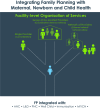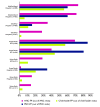Postpartum family planning integration with maternal, newborn and child health services: a cross-sectional analysis of client flow patterns in India and Kenya
- PMID: 29615443
- PMCID: PMC5892750
- DOI: 10.1136/bmjopen-2017-018580
Postpartum family planning integration with maternal, newborn and child health services: a cross-sectional analysis of client flow patterns in India and Kenya
Abstract
Objectives: Maternal, newborn and child health (MNCH) services represent opportunities to integrate postpartum family planning (PPFP). Objectives were to determine levels of MNCH-family planning (FP) integration and associations between integration, client characteristics and service delivery factors in facilities that received programmatic PPFP support.
Design and setting: Cross-sectional client flow assessment conducted during May-July 2014, over 5 days at 10 purposively selected public sector facilities in India (4 hospitals) and Kenya (2 hospitals and 4 health centres).
Participants: 2158 client visits tracked (1294 India; 864 Kenya). Women aged 18 or older accessing services while pregnant and/or with a child under 2 years.
Interventions: PPFP/postpartum intrauterine device-Bihar, India (2012-2013); Jharkhand, India (2009-2014); Embu, Kenya (2006-2010). Maternal, infant and young child nutrition/FP integration-Bondo, Kenya (2011-2014).
Primary outcome measures: Proportion of visits where clients received integrated MNCH-FP services, client characteristics as predictors of MNCH-FP integration and MNCH-FP integration as predictor of length of time spent at facility.
Results: Levels of MNCH-FP integration varied widely across facilities (5.3% to 63.0%), as did proportion of clients receiving MNCH-FP integrated services by service area. Clients travelling 30-59 min were half as likely to receive integrated services versus those travelling under 30 min (OR 0.5, 95% CI 0.4 to 0.7, P<0.001). Clients receiving MNCH-FP services (vs MNCH services only) spent an average of 10.5 min longer at the facility (95% CI -0.1 to 21.9, not statistically significant).
Conclusions: Findings suggest importance of focused programmatic support for integration by MNCH service area. FP integration was highest in areas receiving specific support. Integration does not seem to impose an undue burden on clients in terms of time spent at the facility. Clients living furthest from facilities are least likely to receive integrated services.
Keywords: child health; family planning; integration; maternal and newborn health; postpartum.
© Article author(s) (or their employer(s) unless otherwise stated in the text of the article) 2018. All rights reserved. No commercial use is permitted unless otherwise expressly granted.
Conflict of interest statement
Competing interests: None declared.
Figures



References
Publication types
MeSH terms
LinkOut - more resources
Full Text Sources
Other Literature Sources
Medical
